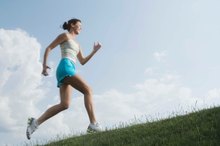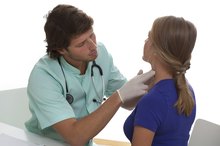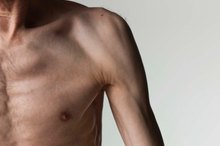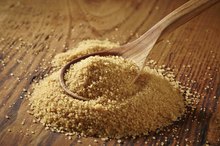Exercises for Hyperthyroidism
Hyperthyroidism is a medical disorder that causes the thyroid to be overactive 4. Those who suffer from this condition have a metabolism that works quickly, which can cause weight loss, irritability and heart palpitations that can cause discomfort.
Along with a hyperthyroidism diet and exercise, medication is an important part of managing hyperthyroidism. The Office on Women's Health warns that exercise can be more difficult for people with a thyroid disease, so it's important for you to talk with your physician before beginning any type of exercise 1.
Read more: Could Your Thyroid Be the Culprit? Everything You Need to Know About Thyroid Disease
What is Hyperthyroidism?
According to the Office on Women's Health, there is more than one form of hyperthyroidism: Graves' disease, thyroiditis and toxic nodular goiter 1.
In addition, you might experience weight loss despite increased appetite and muscle weakness, according to the Mayo Clinic 4. Doctors can perform blood tests to detect hyperthyroidism and sometimes use ultrasound and thyroid scan to help make a diagnosis 4.
Hyperthyroidism and Exercise Intolerance
Importance of Exercise With Thyroid Disease
Learn More
After hyperthyroidism has been diagnosed and well-managed, with the help of your doctor, you can start thinking about exercise. Thyroid disease is sometimes linked to osteoporosis. To help fight osteoporosis, which decreases the density of your bones, it's suggested that hyperthyroidism patients eat a healthy diet, take a calcium supplement and do some weight-bearing exercises.
However there is a link between hyperthyroidism and exercise intolerance as well. Be sure to discuss your exercise plans with your doctor for proper monitoring.
Read more: How to Manage Hypothyroidism With Diet and Exercise
- After hyperthyroidism has been diagnosed and well-managed, with the help of your doctor, you can start thinking about exercise.
- To help fight osteoporosis, which decreases the density of your bones, it's suggested that hyperthyroidism patients eat a healthy diet, take a calcium supplement and do some weight-bearing exercises.
General Exercise Recommendations
The Centers for Disease Control and Prevention offers general exercise guidelines for people looking to maintain a healthy weight 2. First on the list is aerobic exercise — a minimum of 150 minutes of moderate intensity or 75 minutes of vigorous intensity aerobic exercise per week. The best aerobic exercises engage the large muscles of your body, which could include taking a dance class, biking or swimming.
Include strength training at least twice per week, with at least 48 hours between sessions that focus on the same muscles. Resistance exercises include using resistance bands, doing heavy gardening or doing body-weight exercises such as push-ups and sit-ups. Remember to include weight-bearing activities to help prevent osteoporosis, such as walking and stair climbing.
- The Centers for Disease Control and Prevention.
- The best aerobic exercises engage the large muscles of your body, which could include taking a dance class, biking or swimming.
Yoga, Meditation and Tai Chi
Can I Eat Seaweed If I Have Hyperthyroidism?
Learn More
Some alternative activities you can try include yoga, meditation and tai chi. According to the National Center for Complementary and Alternative Medicine, meditation can help patients cope with illness, increase calmness, improve psychological balance and improve overall health 35.
Yoga can help ease anxiety and insomnia for people with Grave's disease. Tai chi, which is a type of martial art that consists of fluid, dance-like moves, can be done to balance and strengthen a person's energy.
- Some alternative activities you can try include yoga, meditation and tai chi.
- Yoga can help ease anxiety and insomnia for people with Grave's disease.
Related Articles
References
- Office on Women's Health: "Thyroid Disease Fact Sheet"
- Centers for Disease Control and Prevention: "Healthy Weight"
- National Institutes of Health: "Bone Health for Life"
- Mayo Clinic: "Hyperthyroidism (Overactive Thyroid)
- National Center for Complementary and Integrative Health: "Meditation: In Depth"
- Endocrinology & Metabolism International Journal: "Physiological Changes of Exercises of Thermogenesis, Thyroid Homeostasis and Inflammation"
- Boelaert K, Torlinska B, Holder RL, Franklyn JA. Older subjects with hyperthyroidism present with a paucity of symptoms and signs: a large cross-sectional study. J Clin Endocrinol Metab. 2010 Jun;95(6):2715-26.
- Garber J et al. Clinical Practice Guidelines for Hypothyroidism in Adults: Cosponsored by the American Association of Clinical Endocrinologists and the American Thyroid Association. Endocr Pract. 2012 Vol 18 No. 6 Nov-Dec;18(6):988-1028.
- Lin TY et al. Incidence of abnormal liver biochemical tests in hyperthyroidism. Clin Endocrinol (Ocf). 2017 May;86(5):755-59.
- American Thyroid Association. Hyperthyroidism (Overactive)
- American Thyroid Association. Graves’ Eye Disease (Graves’ Ophthalmopathy or Graves’ Orbitopathy)
- U.S. National Library of Medicine. MedlinePlus. Thyroid storm
- American Thyroid Association. Hyperthyroidism in Pregnancy
- Boston Children's Hospital. Hyperthyroidism
- Boelaert K, Torlinska B, Holder RL, Franklyn JA. Older subjects with hyperthyroidism present with a paucity of symptoms and signs: a large cross-sectional study. J Clin Endocrinol Metab. 2010 Jun;95(6):2715-26.
- Garber J et al. Clinical Practice Guidelines for Hypothyroidism in Adults: Cosponsored by the American Association of Clinical Endocrinologists and the American Thyroid Association. Endocr Pract. 2012 Vol 18 No. 6 Nov-Dec;18(6):988-1028.
- Kurtoglu S, Ozdemir A. Fetal neonatal hyperthyroidism: diagnostic and therapeutic approachment. Turk Pediatri Ars. 2017 Mar;52(1):1-9. doi: 10.5152/TurkPediatriArs.2017.2513
- Lin TY et al. Incidence of abnormal liver biochemical tests in hyperthyroidism. Clin Endocrinol (Ocf). 2017 May;86(5):755-59.
- Luewan S, Chakkabut P, Tongsong T. Outcomes of pregnancy complicated with hyperthyroidism: a cohort study. Arch Gynecol Obstet. 2011 Feb;283(2):243-7.









